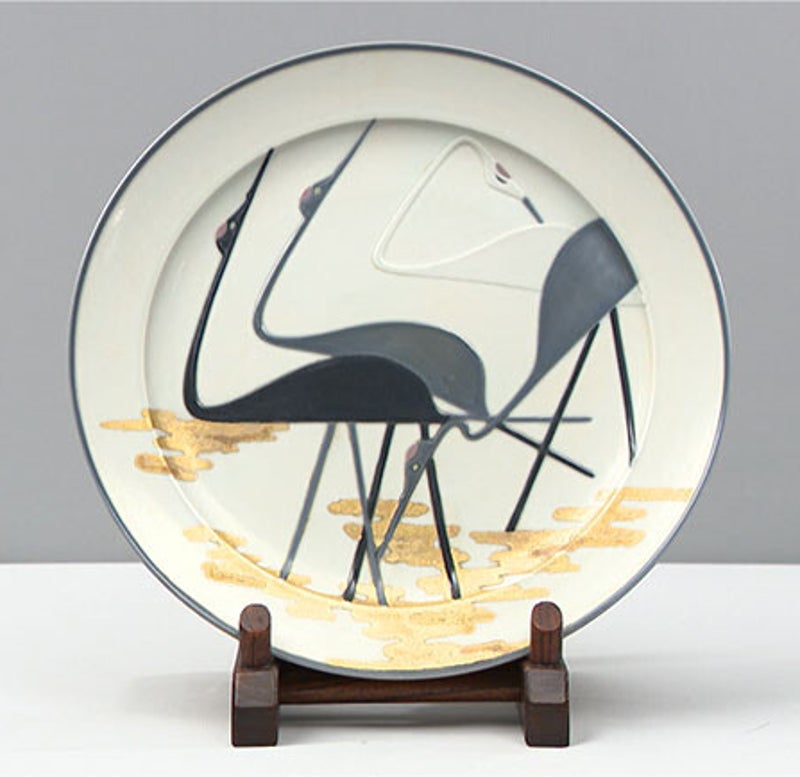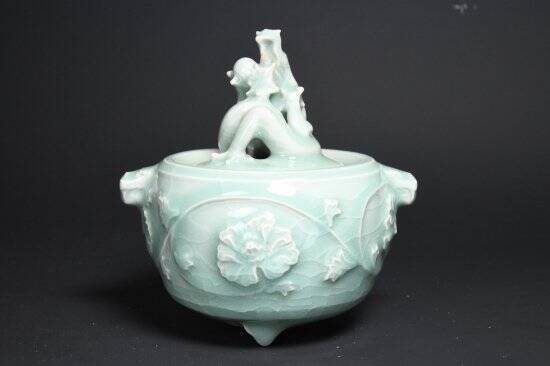21. Kusube Yaichi
Kusube Yaichi (1897-1984 )
楠部 彌弌
Kusube Yaichi was born in 1897 in Higashima, Kyoto and joined at Young age the School of the Kyoto Ceramic Experimental Training Centre, together with other later prominent artists as Yagi Isso and Hamada Shoji. It was a time that potters more and more started to understand themselves not merely as producers of decorative ware, but as artists able to create individual works of art and design. It is likely that the students at this school were trained in this new conception of their crafts. In 1918 he started to make ceramics in Sanjo, Kyoto and in 1920, when he was only 23 he founded the avant-garde group of ceramists “Akatsuchi”.
Yaichi Kusube was a prominent ceramic artist, who received many prices in his life time. He was awarded in 1924 at the Paris Universal Exposition and received many other prices the years after. In 1962 he became a member of the Japan Art Academy, in 1972 he was designated a person of cultural Merits by the city of Kyoto and in 1978 he receveid the Order of Cultural Merit. Yaichi Kusube died in 1984.


Portrait of Yaichi Kusuba s a young man and his signature.
Note:
Kusube is one of the most common names on Satsuma pottery. The quality ranges from moderate to fairly good, and only occasionally high quality. These pottery marked Kusube were all produced by Kusube Pottery Factory founded and directed by Kusube Sennosuke (1859-1940), the father of Yaichi Kusube. A common mistake is to attribute work produced by this Kusube company to Yaichi Kusube. Serious auction houses and antique dealers obviously know the difference, but on auction sites such as e-bay and also at somewhat smaller auction houses, these Satsuma-style works signed "Kusube" are often offered as Kusube Yaichi. Given the year of Yaichi's birth (1897), it is clear that all the work Kusube made during the Meiji and early Taisho period cannot be Yaichi's. Moreover, Kusube Yaichi was a modern ceramicist; his work is of a very different nature from that of his father. In fact, based on Yaichi's biographical data (see his extensive biography on this page), it is unlikely that Yaichi Kusube ever worked (intensively) in his father's business. He concentrated on modern pottery from an early age and was successful at it. It is possible that Yaichi helped his father (who was in his seventies at the beginning of the Showa period) develop the more modern Kusube work of the late Taisho and Showa periods. This modern style, characterized by stylized, brightly colored figures with moriage on a mostly white glazed background, is clearly identifiable compared to the more common way of decorating in traditional colors, where the background was glazed dark brown or cobalt blue. Thus, although it is possible that Yaichi Kusube was responsible for the more modern designs of the Kusube workshop, even then they may not be called the work of Yaichi Kusube because they are presented only as Kusube, namely the Kusube Pottery Trading Factory.
Examples of works by Yaichi Kusube







Biography.
1897: Born in the Higashiyama district, Kyoto City, the fourth son of father Sennosuke and mother Tomi. His father managed the Kusube trade in pottery factory.
1912: Went to the training school attached to the Kyoto City Ceramics Examination Center. Kazusou Yagi, Kitaro Kawamura and others joined at the same time.
1915: Graduated from the training school. Received the incentive prize at an exhibition sponsored by the Ceramic Youth Association. Rented a studio in Awatayama and began his life as a potter.
1918: Moved to a workshop in Awataguchi and began working seriously with pottery.
He formed friendships with Tsunei Kawakami, Junkichi Mukai, Tatsuaki Kuroda and Kanjiro Kawai .
1920: Announced the rules of the pottery group ``Akado'' with Kazusou Yagi, Kitaro Kawamura, Toshimasa Michibayashi, Einosuke Kawai, Yoshikage Araya and others. The first Red Clay exhibition was held in Takashimaya, Osaka. The second Red Clay exhibition was held at Kyoto Prefectural Library.
1921: The third Red Clay exhibition was held at Hoshi Pharmaceutical in Tokyo.
The fourth Akato meeting was held at Kyoto Prefectural Library .
1922: Held a two-person exhibition with Ichiso Yagi at Tsuboya, Osaka.
1923: "Red earth" will disappear naturally.
1924: Exhibited the ``100 Buddha Decorative Vase'' at the Paris World's Fair and won a prize. Meet Soetsu Yanagi.
1925: Interested in Soetsu Yanagi's folk art movement and collects folk art.
1926: Married to Shichi Motoe (later changed his name to Kiko). Exhibited at the Japanese crafts exhibition and purchased by the Ministry of the Imperial Household.
1927: Formed Yoyo-kai with Kazusa Yagi, Kitaro Kawamura, Einosuke Kawai and others. Opened the craft department at the Teiten exhibition and was selected for the 8th exhibition.
1933: Awarded special selection at the 14th Teiten exhibition and purchased by the Imperial Household Ministry.
1934: Recommended for the Teiten exhibition.
1935: Exhibited at the first Kyoto City Exhibition.
1937: Awarded at the Paris World's Fair.
1938: Settled in the Okazaki Enshoji Temple and built a workshop.
1943: Founded Jakuchu-kai with Isamu Yoshii, Chikutaka Ono and Iemoto Omotesenke.
1948: A Kyoto Craft Artists Deliberation Committee was formed. The "Memorial Red Clay Ceramics Exhibition" was held in Nanzenji Hojo.
1951: Received the Minister of Education Award for Art Encouragement at the 7th Nitten. Judge of the same exhibition.
1952: Becomes a council member at Nitten.
1954: Received the Japan Art Academy Award.
1956: First solo exhibition held at Mitsukoshi in Tokyo and Osaka.
1958: Becomes Nitten council member.
1959: 2nd solo exhibition held at Mitsukoshi in Tokyo and Osaka.
1962: Becomes a member of the Japan Art Academy.
1963: 3rd solo exhibition held at Mitsukoshi in Tokyo and Osaka. Medal with dark blue ribbon received.
1964: Exhibited at the ``Contemporary International Ceramics Exhibition'' at the National Museum of Modern Art, Tokyo and Kyoto.
1965: Established a workshop at the Kiyomizu-yaki residential complex in Yamashina, Kyoto.
1968: The ``50th anniversary exhibition of Yaya Kusube ceramics'' was held in Osaka, Tokyo Mitsukoshi and the Kyoto Municipal Museum of Art. Serialized ``Soil and Fire'' in the Mainichi Shimbun.
1969: Became a Kyoto city person of cultural merit. Appointed executive director of Nitten.
1971: ``Self-chosen exhibition of Yaya Kusube, the pinnacle of the Japanese ceramic art world'' was held at Osaka Hanshin and Tokyo Mitsukoshi department store .
1972: Received the Mainichi Art Prize. Become a person of cultural merit.
"Yaiya Kusube New Works Exhibition" was held at Mitsukoshi in Tokyo and Osaka .
1973: Appointed advisor to Nitten.
1974: The ``60 Years of Irozuchi Beauty Exhibition -.Yaichi Kusube Exhibition'' was held at Tokyo Shibuya Tokyu and Osaka Hanshin department stores.
1975: Became an honorary citizen of Kyoto.
1977: Stayed in Paris and held the ``Exhibition of Japan's Beautiful Artistic Ceramics by Yaya Kusube'' at the Musée des Arts Décoratifs in Paris.
1987: Received the Order of Culture.
1980: "Yaichi Kusube Exhibition" was held at Takashimaya in Tokyo and Osaka.
1982: ``Kusube Yaichi Tea Bowl exhibition'' held in Tokyo Mitsukoshi and Kyoto Daimaru. Became honorary president of the Japan New Crafts Federation.
1984: On December 18, 1984, Yaichi Kusube died in Kyoto due to chronic kidney failure.
© 2014 陶芸のススメ.


Maak jouw eigen website met JouwWeb